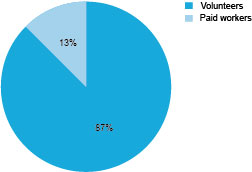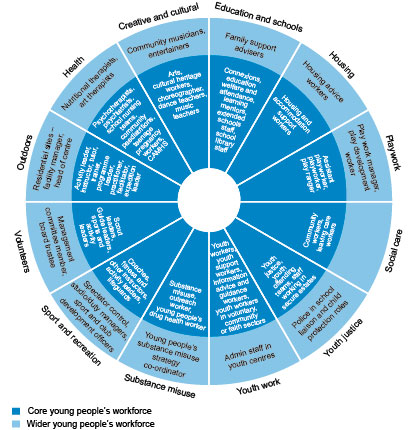The CWDC audit of work with young people
In 2009, a survey of those who work with young people was carried out in England by the Children’s Workforce Development Council (CWDC, 2009) – an organisation whose work has now been taken over by the Department for Education and the Children’s Improvement Board. The 2009 audit identified over 6 million workers working with young people, divided between volunteers and paid workers (as shown in Figure 2).
Once again, the audit shows the scale of the work that takes place with young people on a paid and unpaid basis.
The largest sectors of paid workers were in sport and recreation, health, play work and youth work. Of these, around two-thirds of youth and community workers, two-fifths of sport and recreation/outdoors workers and one-third of play-work staff work full time (CWDC, 2009), reflecting the potential of work with young people as a possible career option. However, as in Scotland and Northern Ireland, the great majority of workers were volunteers, reflecting a long tradition of this kind of work.
The next activity uses the framework developed as a result of the CWDC audit to help you to start to locate yourself within the bigger picture of those who work with young people. The CWDC framework is just one way of ‘cutting the cake’ and dividing work with young people into categories, but we hope it is one you find illuminating.
Activity 3: Locating your work in the bigger picture
Look at Figure 3, which was produced by the CWDC audit. You will see that it is divided into different segments and also different shades. The darker sections describe front-line practitioners with young people – that is, people who usually work face to face with young people and who are described by the CWDC as the ‘core young people’s workforce’. The lighter sections illustrate those people who spend some of their time working with young people and some (perhaps more) with other people – described by CWDC as the ‘wider young people’s workforce’. For example, a community musician might spend some of her time working with older people, families or younger children and some of her time working with young people.
Identify where you and your work might fit within this wheel.
- If you work with young people, see if you can identify the sector within which your work might be placed – such as health, youth work or youth justice.
- If you have identified a sector, now think about whether you would place yourself within the darker blue section of core practitioner or the lighter blue section of ‘occasional’ worker with young people.
- If you don’t currently work with young people, consider roles that you have had in the past or places that you went to and services that you used as a young person. Are you able to place those on the wheel?
- If you work with young people or would like to, think about where you might like to be on this wheel. You might be happy where you are or you might aspire to a different role.
Make a note of your answers in the box below.
Discussion
You may be surprised at this range of work with young people – or you may be experienced in this field and feel that you are familiar with at least some of the different sectors. You may already be thinking about the similarities and differences between the work in different parts of the wheel. We will continue our discussion looking at different ways of understanding these. Note that some people who ‘work with young people’ have been omitted from this wheel and were not included within the audit. This includes, for example, people providing formal compulsory education, or post-16 education or training, and social workers. This is because our primary consideration here is work with young people and ‘informal education’ which we will examine more closely in the next section.


